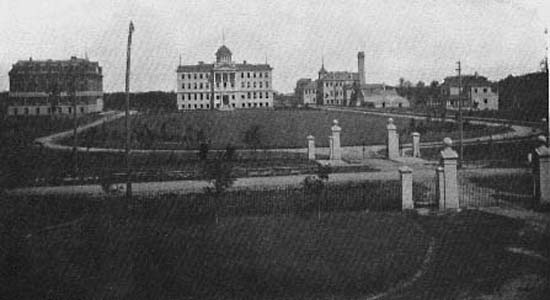Search | Image Archive | Reference | Communities | POV | Lesson Plans | Credits
 After 1905 the agricultural education movement on the prairies was strengthened when the province of Manitoba established the Manitoba Agricultural College (MAC).
After 1905 the agricultural education movement on the prairies was strengthened when the province of Manitoba established the Manitoba Agricultural College (MAC).
It might be argued that the objectives of the College had less to do with teaching students how to farm as then with equipping those who already knew how to farm with the scientific and management tools to make them better farmers. The College offered a core curriculum of coures in horticulture and field husbandry, agricultural engineering, animal husbandry, and natural history. In addition to these practically oriented courses, programmes were offered in the fields of agricultural economics, accounting and farm management, courses which reflected the increasing professionalization of farming.
Alongside the faculties that taught farming practises, MAC offered course in Household Sciences and Home Economics. This home economics division offered courses in foods and nutrition, clothing and textiles, physiology and hygiene and institutional management to women, and reflected a growing professionalization of the domestic sphere in rural society.
In addition to being a centre of teaching, the College was a centre of research and experimentation. College agronomists conducted research into agricultural techniques, inventing and improving machinery, determining the optimal methods for weed and insect control, tillage and ploughing, and crop rotation.
The College was also a primary instrument of agricultural education beyond its own classrooms and laboratories, and it counted among its objectives to bring news of agricultural developments to the attention of established farmers. The College sponsored field experiments and demonstration crops on private farms. It conducted extension courses, lecture series and practical demonstrations at which farmers could learn more about soil and moisture conservation, traction engineering, seed cleaning, and other aspects of modern farming. Between 1912 and 1914, these educational programmes took to the rails, as the College co-operated with the Agricultural Extension Services to send two Better Farming Trains across the province.
The College was located in the southwest corner of the City of Winnipeg until 1912, when it moved to a new campus south of the city on what was later to become the main campus for the University of Manitoba. The buildings formerly occupied by the Manitoba Agricultural College were thereafter put to use as the Fort Osborne Barracks, replacing the old downtown barracks which were torn down to make room for the new Legislative Building.
See also:
Historic Sites of Manitoba: Manitoba Agricultural College / Manitoba School for the Deaf / Fort Osborne Barracks / Asper Jewish Community Campus (123 Doncaster Street, Winnipeg)
Page revised: 19 May 2024